

387th BOMBARDMENT GROUP (MEDIUM)
(back to Group
main page)
MacDill Field
Tampa Bay, Florida
B-26 MAURAUDER UNITS TRAINED AT MACDILL, 1942-43
-
21st Bombardment Group
-
320th Bombardment Group
-
322nd Bombardment Group
-
323rd Bombardment Group
-
336th Bombardment Group
-
344th Bombardment Group
-
386th Bombardment Group
-
387th Bombardment Group
-
391st Bombardment Group
-
394th Bombardment Group
-
397th Bombardment Group
| Of the USAF B-26 combat units, every one other than the 17th, 22nd,
28th, 38th and 319th Groups would claim MacDill Field as its beginning
or later base. Under the leadership of the III Bomber Command, MacDill
Field had been the home of the 20th Group from January 1942 to October
1943. Beginning with the 320th Group in June 1942, from MacDill Field would
be launched the 322nd, 323rd, 344th, 386th, 387th, 391st and 397th Groups.
– John O. Moench, Maj. Gen.,
USAF, Marauder Men, p. 86. |
MacDill Field is located on
a narrow peninsula jutting about two and one-half miles into Tampa Bay
(1942). Photo courtesy United States Air Force.
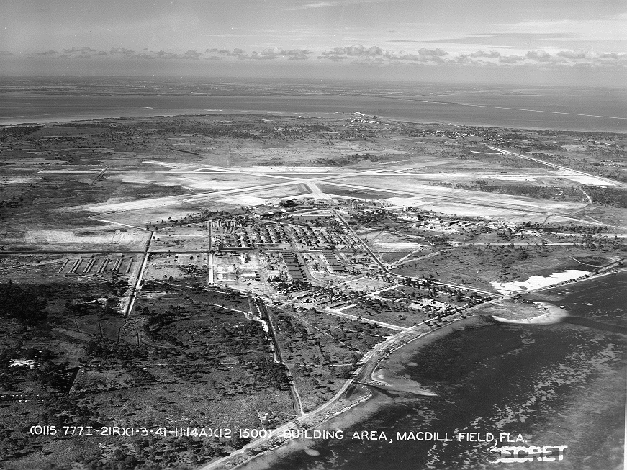
Hangar area, with new hangers under construction (c. 1942). Photo
courtesy United States Air Force.
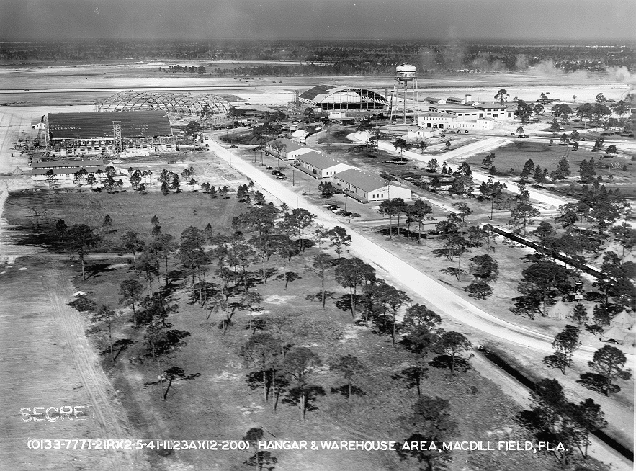
Twenty-five B-26s parked on
the ramp for inspection. The large numbers painted on the fuselages, called
"buzz numbers," were intended to discourage reckless flying by enabling
civilians calling in with complaints to identify the offending aircraft.
"Those big numbers were 53 inches in height with stroke of 9 inches and
the numbers from 2 through 0 were 26 inches in width. Space from the trailing
edge of the wing to the waist windows was ample." Photo courtesy Leslie
C. Hard.
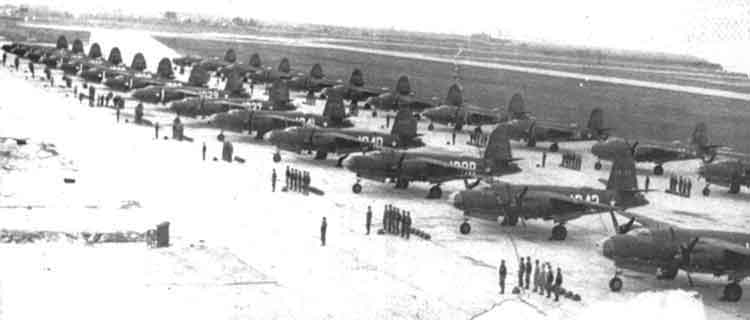
A "J" boat, part of MacDill's
Navy, on patrol in the Gulf of Mexico during World War II (c. 1943). These
boats plied the coastline to pick up downed fliers or retrieve bailed-out
aircrews. Photo courtesy United States Air Force.
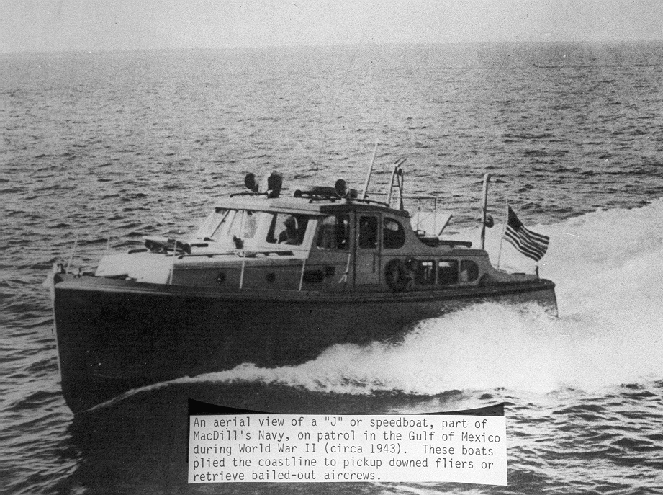
Band posing in front of B-26 Maurauder, MacDill Field, Florida 1943
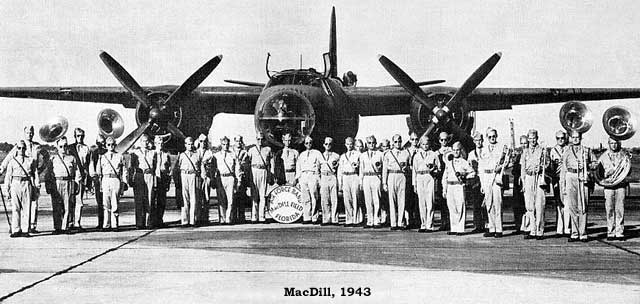
"One a day in Tampa Bay"
In the latter part of 1942
at MacDill, thirty-four accidents claimed fifty-six lives despite a favorable
climate and air approaches free of obstructions.
In 1943 MacDill was still engaged
in medium bombardment training. The training units welded pilots, navigators,
bombardiers, gunners, radio operators and engineers into combat crews.
The pace they were required to set was determined by the urgency of total
war. Forging competent operational units demanded intense formation flying.
In spite of B-26 modifications and growing knowledge of how to fly the
airplane, the accident rate at MacDill remained high throughout 1943, totaling
sixty-three accidents. Some of the aircraft never returned from flights
over the Gulf of Mexico.
During WWII at MacDill AFB
the stubby winged B-26 Maurauders with a pair of 2000 hp engines were dropping
like flies in Tampa Bay. Les Mulzer noticed the established landing pattern
was too low and that landing gear and flaps were being extended too early.
By simply raising the pattern altitude, delaying the extension of the gear
and flaps and steepening the final approach he helped sove the problem.
Cappie Bie, writing in the Maurauder Thunder V2N1.
We were beginning to have
enough trouble with the Curtis prop that they installed a hydraulic system
in to control the propeller. When we began to use the hydraulic system
we found it easier to use, but we found some new problems. We were picking
the airplanes up at the Martin plant which was located in Middle River
just north of Baltimore, Maryland on the shore of Chesapeake Bay. We were
having an occasional plane descend into the bay. Nobody could figure out
why. You would take off over the water and while beginning to climb out
your aircraft would begin to settle. You had the correct power setting
and the proper angle of climb, but the plane would settle into the bay.
There was a B-26 base in Tampa, Florida that was having the same problems.
They coined a phrase “one a day into Tampa Bay.” We couldn’t find out what
was going wrong.
The project officer at the
Martin plant began to accuse the pilots of not trying to get the planes
up. He said that he would show us how it was done. He went out there, took
off and began to settle into the bay. He skimmed it right in. The rescue
boats went out and brought him and his co-pilot in. The 26 was an easy
plane to get out of. You just opened the cockpit windows and while it was
sinking, you just went to the top. Right after that incident, they began
to put the Curtis Electric propeller controls back into the aircraft again.
The majority of the pilots seemed to be in fafor of the Curtis Electrics
anyway. When we stopped using the hydraulic system the “one a day into
any bay” came to a halt.
-Cas. X. Governat, quoted in Maurauder Thunder V1N3.
Buzz Numbers
Local civilians also expressed
concern. A growing uneasiness in Tampa may have been heightened by the
comment made at a public meeting by an Army Air Force officer who explained
that "The vital drive, the urge to fly in a manner approaching recklessness
and lack of fear are qualities which have made American pilots feared and
respected in combat--these same qualities have also contributed to some
accidents in routine operations." Some of the reckless flying was
in violation of regulations. Since low flying aircraft alarmed animal herds
and ranchers, the Army responded to complaints by painting large numbers
on the sides of aircraft so that they could be identified and reported.








